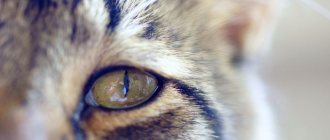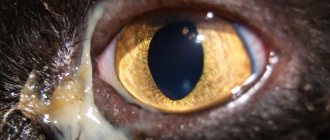If a cat’s ear is leaking, then pet owners should not ignore such signs, as they can be a signal of serious problems. Brown or clear liquid in the area of the ear canals may indicate an inflammatory process; such a manifestation is the result of mechanical damage. If there is a problem, contact a veterinary clinic, where a specialist will conduct a comprehensive examination and select the necessary treatment.
Mechanical injuries: wounds, scratches, abrasions
They arise due to strong mechanical stress.
As a rule, they are the result of “March games”, as well as fights with other cats. Most often, lesions of this type are either bitten or torn. They are subject to abundant contamination with pathogenic and conditionally pathogenic microflora, which is why they become severely inflamed and fester profusely. This is precisely the reason for the existence of many homeless animals, from whose ears only small “stubs” remain.
Symptoms and treatment
Diagnosing such injuries is simple: they are easily detectable visually, and their signs are hard to miss. The doctor must only determine the severity of the inflammatory process. If the latter is especially severe, purulent or ichorous exudate is released, and a sample of pathological material is taken. It is used for microscopic examination and seeding on nutrient media. It is necessary to accurately determine the type of pathogen in order to prescribe adequate and effective therapy.
By the way, how are these injuries treated? In mild cases, it is sufficient to treat the affected ear(s) with hydrogen peroxide followed by the application of iodine or brilliant green.
This treatment at home leads to a pronounced positive result within a couple of weeks.
If the inflammatory process is severe and the case is advanced, surgical treatment of the affected surface will most likely be required. Dead tissue is carefully cut out. Sometimes cats have to undergo a forced procedure of ear cropping: to ensure that the edges of the ears are smooth and neat, and not “frayed” and uneven, it is better to immediately trim and trim them.
The edges of the wound are carefully tightened with sutures. To do this, they try to use materials that dissolve in the body over time (i.e., there is no need to remove sutures).
When a cat’s condition is severe due to a widespread inflammatory process, there is lethargy, refusal to feed and elevated body temperature, the animal is prescribed broad-spectrum antibiotics and other antimicrobial drugs.
If the wound continues to fester, you need to carefully soak and remove crusts of dried exudate daily using a cotton swab and hydrogen peroxide. If this is not done, maceration (softening) of the skin and coat will occur. The ears will become bald, which will not make your pet particularly attractive. But it’s much worse that the bare areas themselves can become inflamed, which will further complicate and worsen the process.
Forms of ear inflammation
The forms of ear inflammation are of great importance for diagnosis and in prescribing treatment. Note that all of the following forms of otitis media can be either acute or chronic.
Allergic otitis media
Many breeders do not understand how allergies and ear inflammation can be linked. But in fact, allergic otitis media develops quite simply:
- Due to an allergic reaction, histamine is released from mast cells.
- The local porosity (permeability) of blood vessels increases, after which lymphocytes begin to move towards the site of the allergen.
- Inflammation develops.
This form of otitis media is characterized by severe swelling, redness and itching. A pronounced pain reaction does not always occur; the general condition of the pet is usually relatively normal.
Purulent otitis media
Perhaps the most severe form of pathology is purulent otitis media. It is usually a consequence of bacterial infections. In addition, purulent inflammation often develops due to foreign bodies entering the ear.
This type of pathology is severe, accompanied by severe fever of a constant or intermittent type, refusal of food and a significant deterioration in the general condition of the pet. The ears are swollen and hot, and pus is released from the ear canals. If the inner ear is damaged, neurological seizures and even coma are possible.
Serous otitis media
Another common (but not as severe) form of inflammation is serous otitis media. This type of pathology is characterized by swelling and copious discharge of serous exudate (looks like a clear, yellowish liquid). In addition, with the serous type of inflammation, severe itching is not uncommon, causing the pet to constantly scratch and scratch its ears. As a rule, the serous type of inflammation develops against the background of otitis of allergic etiology.
Fungal otitis media
Not only purulent otitis, but also fungal otitis is extremely dangerous for the animal. Develops in animals with seriously weakened immune systems. It occurs as a consequence of advanced otodectosis and frequent allergies.
At the same time, strange growths appear in the cat’s ears, and a strange (moldy or cheesy) smell emanates from the ears themselves. Large amounts of thick, odorous exudate may be released from the ear canals. The general condition of the pet is depressed, depressed.
Bacterial otitis
Note that bacterial otitis can occur in the form of purulent inflammation, it can develop simultaneously with fungal or allergic. In fact, this is the most “universal” form of inflammation. As a rule, the causative agents are streptococci and staphylococci. Often accompanied by purulent inflammation and the release of large volumes of purulent exudate, an increase in local and general body temperature.
Anatomy of the ears of cats and cats
The ear is the organ of hearing and balance. It consists of outer, middle and inner.
The outer ear includes the pinna (the visible part of cartilage covered by skin, fur, or hair) and the ear canal. The ear canals of cats and kittens are deeper and more conical than those of humans. This deeper canal is prone to the accumulation of dirt and wax, leading to inflammation and secondary infections.
Cats' hearing is many times more sensitive than humans'.
The middle consists of the eardrum and an air-filled chamber that contains 3 tiny bones, 2 muscles, the oval window and the eustachian tube.
The inner ear is a complex structure that includes the cochlea (the organ of hearing) and the vestibular system (the organ of balance).
Anatomy of a cat's ear
When not to worry
The ears appear hotter than other parts of the cat's body due to the fact that there are blood vessels under thin skin that is not protected by fur. Due to their location, they quickly heat up from the sun, lamp, radiator and also cool down quickly (it is by the ears that you can determine that the animal is freezing).
From a heat source, the ears heat up faster than other parts of the cat’s body, since there is a dense network of capillaries, as close as possible to the skin
Warm ears themselves are not an indicator of fever (unlike a dry nose in an awake cat). But you should play it safe and measure the general body temperature of the beast with flaming ears (this is done using a rectal thermometer). The norm is:
- in a newborn kitten - 35.1–36.1 °C;
- for kittens up to six months - within 38.5–39.5 °C;
- for adult cats - 37.5–39 °C.
It's okay if the cat has hot ears, but the general body temperature is fine and there are no other alarming symptoms. Just in case, feel the animal’s ears after a short period of time - if the animal is overheated or nervous, then after 15–20 minutes the skin will again feel normal to the touch.
In what cases is it necessary to contact a veterinarian?
Since otitis media is an extremely dangerous disease, it is necessary to pay attention to any strange and alarming behavior of the cat. Here are the cases in which you will need to contact a veterinarian:
- The animal clearly shows signs of damage to the vestibular apparatus (the animal cannot maintain stability, falls out of the blue, etc.).
- Pets that are experiencing neurological seizures should be taken immediately to the veterinarian. These signs indicate damage to the central nervous system.
- You also cannot do without the help of a specialist in cases where the animal completely refuses food for a day or more. In addition, it is urgent to take the cat to the doctor if the pet does not drink.
- Veterinary care is required for cats suffering from unbearable pain and itching.
- In addition, it is necessary to contact the clinic if the animal is too apathetic, does not react to anything, or lies flat.
Why do my ears get hot?
Owners are very worried when their pets get sick. After all, an animal cannot say what is bothering it. They touch his nose: it should be wet. Sometimes the temperature of the ears is also checked.
Norm
Hot ears occur not only when the cat is sick, but also:
- during sleep, when the organ is heated under the sun or from a battery;
- after long and stormy games;
- if the cat is nervous or overexcited;
- when the pet has been in a hot and stuffy place for a long time.
In these cases there is no cause for concern.
Pathology
If, after measuring the temperature, the column shows an excess of the permissible values, changes in the pet’s behavior are observed, it is most likely sick. There is no point in trying to treat it yourself. This can cause harm.
The cat needs to be shown to a veterinarian. Only he is able to determine the pathogenesis of the pathological condition and select the correct treatment regimen.
What reasons should be excluded first?
If your cat’s ears are leaking, it’s best not to guess, but to immediately take your pet to the veterinarian. Without cytological, microscopic and histological examination it is impossible to make a diagnosis. At the appointment, the veterinarian will examine the ear canal, get acquainted with the existing symptoms (usually itching, discharge, foul odor, redness, etc.), and collect the discharge to carry out the necessary diagnostic measures to confirm or exclude the following possible causes:
- Ear mite. The most common cause of various types of ear problems in cats. Characteristic symptoms usually include redness of the inside of the ear, peeling, foul odor and severe itching. Brown liquid with an unpleasant odor may also flow from both ears. Infection occurs through close contact with an infected animal or objects with which it has been in contact. If treatment is not started in time, there is a high probability of complications of the process with a bacterial infection, since due to severe itching the animal will constantly scratch the temple area until there is blood and sores. To make a diagnosis, discharge from the ear canal is taken for cytological examination and deep plucks from both ears for microscopic examination. If a tick is detected, then medications are selected for treatment, which are applied to the animal’s withers or buried inside. Complete recovery is considered to be the complete absence of mites in the last scrapings.
- Foreign body. If a cloudy fluid resembling pus flows from a cat’s ear, then the possibility of a foreign body getting inside should be ruled out. Outdoor pets have a risk of getting plant seeds, branches from trees or bushes into the ear canal. Pets most often suffer from food or plants they have access to (cacti) getting inside their ears. In most cases, a foreign body is accompanied by an inflammatory process (purulent otitis), which can only be eliminated by removing the splinter from the auricle and carrying out symptomatic treatment. Since, in addition to the discharge, there is almost always a foul odor from one organ of hearing and severe itching. You can also tell that something is wrong with an animal by the squelching sounds that can be heard when it shakes its head. If a cactus needle, the remnant of another animal’s claw, or a twig that you can get out yourself has gotten under your skin, you can use tweezers pre-treated with a chlorhexidine solution to remove it. But, in most cases, the veterinarian still has to remove the foreign body from the cat’s ear canal using special gripping tools. He will also select anti-inflammatory and antibacterial drops that will help prevent the development of bacterial otitis.
- Allergy. For the most part, this is a problem with decorative breeds, which suffer from food allergies and atopic dermatitis from birth. Allergic otitis is quite common in Maine Coons, Exotics, Persians and Sphynxes. Characteristic symptoms are the appearance of dirty discharge with an unpleasant odor inside the ear, redness of the skin and peeling. There may be sores and sores in the area of the temples and the outer side of the ear, as a result of scratching due to severe itching. You need to understand that allergic otitis media is treated symptomatically during an exacerbation. It is not possible to completely recover from it. In some cases, switching to holistic food or other medicinal, hypoallergenic foods helps a lot. The most difficult thing is in cases of atopic dermatitis, since the potential allergen can even be contained in house dust or mold, which is almost impossible to exclude from everyday life.
- Fungal and bacterial infection. We specifically brought these two diseases together, since there are many known cases where a cat has a fungal infection in one ear and a bacterial infection in the other. That is why, to make a diagnosis, it is recommended to take discharge for cytological examination from both ears. After identifying the pathogen, effective drugs (ointments, tablets) are selected.
If an old cat has a leak from one ear, then it is better not to delay a visit to the veterinarian, as this may be the first sign of the development of a tumor process inside the auricle.
Localization of inflammation
As already indirectly mentioned above, the localization of inflammation is a very important sign, since both the severity of the consequences of the disease and the choice of therapeutic technique depend on it.
This also determines how urgent the need for a visit to the veterinarian becomes.
Outer ear
If the outer ear is inflamed, then this is the simplest and most trouble-free option. In this case, only the auricle and external auditory canal are affected (and even then not always). As a rule, symptoms are limited to itching, swelling and redness of the skin of the ears. When palpated, the ears are painful, the cat does not allow you to touch them, hisses loudly. Usually the cause of such inflammation is either an allergic reaction or frostbite.
Middle ear
If the middle ear is inflamed, then everything is somewhat more serious, since much more important elements of the hearing organs are affected. Typically, such otitis occurs as a result of either advanced external inflammation, or with severe otodectosis (much more often), or is a consequence of foreign bodies getting into the ear.
It is characterized by a strong pain reaction, purulent inflammation very often develops, as a result of which the animal’s general body temperature may increase and its general condition will greatly deteriorate. There may be pus or other type of exudate coming from the ear openings.
Inner ear
The worst case is when the inner ear is affected. This can happen either against the background of severe systemic infections (especially of viral origin), or due to advanced cases of otitis media. As in the previous case, the root cause of inflammation can be a deeply embedded foreign body. In the summer, there are times when insects get into a cat's ears. Since the cavity of the inner ear is located in close proximity to the pet’s brain, inflammatory processes in it are fraught with meningitis and encephalitis.
Symptoms are often characterized by inappropriate or strange behavior of the animal, neurological seizures have been repeatedly described, intermittent fever, and complete refusal of food are observed.
Prevention
To prevent the development of ear diseases in cats, owners must systematically examine their pet’s ears and clean the ears from excess wax and plaque. To carry out hygienic procedures, you can use special preventive solutions, hydrogen peroxide. You should not treat your cat’s ears with alcohol solutions, much less instill medicinal or hormonal medications for preventive purposes. The procedure should be carried out only with sterile gauze and cotton pads and ear sticks. Use a separate blank disk for each ear.
Ear cleaning
Avoid hypothermia or prolonged exposure of animals to drafts. When bathing your pet, to prevent water from getting into the ears, you can purchase special ear swabs or close the ear canal with a cotton pad. After swimming, check to see if any water has entered the ear.
Cat scratching its ear
In addition, you need to pay attention to the state of the immune system, introduce multivitamin, mineral complexes and supplements into the diet. If the general condition worsens, noticing the above symptoms of ear diseases, show the cat to a veterinarian
We invite you to join our Zen channel and group on VKontakte or Odnoklassniki, where new articles for pet owners are published.
Preventive measures
To avoid inflammation of the ears and leakage from them, it is recommended to regularly examine your pet and maintain hygiene. The best option is once a week. A balanced and nutritious diet is a must to maintain a strong immune system.
Bath your pet no more often than once every three months, having assessed the need for such an event. When washing, be sure to plug your ears with cotton swabs to prevent water from entering.
Cats' ears can leak for a variety of reasons. But in any case, proper and timely treatment is necessary.
Frequently asked questions about the treatment of otitis media in cats
Question: In what cases may surgical intervention be required?
Answer: In case of advanced inflammation, purulent, to eliminate blockage of the ear canal.
Question: For which otitis media can antibiotics be used?
Answer: They are prescribed only when an infection occurs. In particular, with bacterial, purulent, fungal otitis media.
Question: What happens if otitis media is treated incorrectly?
Answer: This leads to serious complications (for example, perforation of the eardrum, infection in the brain, development of meningitis).
Question: What happens if otitis media is not treated at all?
Answer: Then the inflammation will intensify and the cat’s temperature will rise. When the infection affects the brain, the animal will become deaf. In the worst case scenario, this can lead to the death of your pet.
Complications
The course of otitis media can often become complicated. Slow progression of the disease is also possible, which practically does not cause the main symptoms of the disease. This slow development quite often leads to chronic ear inflammation.
- Facial nerve paralysis – changes in facial expressions, sagging lips, eyelids.
- Purulent inflammation - with this complication, an unpleasant odor may emanate from the cat, and fluid may begin to ooze from the ear.
- Meningitis is an inflammation of the lining of the brain. Frequent vomiting occurs, the animal is in a state of shock, and has a fever.
- Advanced inflammation can also lead to deafness in your pet.
Possible causes of ear disease
Any disease of the auricle is dangerous, as it can lead to complete deafness of the cat and even death. This is due to the fact that the structure of a cat’s ear is very complex, reminiscent in complexity of the human structure, i.e. has internal, middle and external sections. Therefore, inflammatory processes can penetrate to the cat’s brain.
Let's consider the course of some diseases and the causes of their occurrence.
Otodectosis
A disease caused by ear mites. It is sometimes called ear scabies.
It is caused by a tick. It is impossible to see this creature without special devices. Therefore, in this case, a doctor is needed who will conduct an external examination and take an analysis. This disease is quite contagious, so if there are other animals in the house, it is better to remove the one with ear pain.
The tick digs into the thin skin on the cat's ear as it feeds on blood and lymph. The cat begins to scratch its ears, from which a brown liquid is released. It dries out and turns into small crumbs. And even if you clean your cat’s ears every day, there will be no effect. New discharge will appear again and again. Therefore, it is necessary to add treatment prescribed by a doctor to home treatments. The cat's owner will need to treat the cat's ears with a solution of hydrogen peroxide or camphor alcohol, and then apply drops prescribed by the doctor. The course can take from 7 to 10 days.
Hematomas, lymphatic extravasation, abscesses
Any injury to the ear can cause a hematoma, for example, a bruise, a bite, etc. Outwardly, it will look like swelling, the cat's ears will look droopy, and the site of the hematoma will look hot. Only the inside of the cat's ear should be carefully examined, because... hematomas on the outside are very rare. The cat becomes nervous and even aggressive, scratching its ears and constantly shaking its head. Similar ear diseases in cats can lead to severe complications, and in some cases to cartilage necrosis.
Trauma accompanied by the penetration of a pathogenic infection into it can lead to an abscess. Outwardly, it looks a little like a hematoma, but pus accumulates inside. At the same time, the cat’s ear hurts so much that she can bite hard during examination.
Another disease very similar to hematoma is lymphatic extravasation. But in this case, a bubble with liquid (blood or lymph) forms. Any of the listed manifestations of injury requires contact with specialists.
Otitis
This is an inflammatory process that forms in the auricle. This is perhaps the most difficult and painful condition for a pet. With otitis media, a cat's ears may become swollen, the shell will become red, hot, and an unpleasant odor will emanate from inside. In a severe, advanced form, the cat's eyelid may close and the lip may sag. The cat will begin to show strong aggression and will look for a dark, secluded place. How to treat a cat’s ears is necessary to find out from a specialist, since any self-medication will only cause harm and will aggravate the pet’s condition and can lead to complications.
Entry of foreign objects
Such items include sand, particles of plants, insects, sulfur plugs, etc. Some objects may get into a cat's ears without being noticed, but others can irritate the surface of the ear. The cat begins to scratch its ears, trying to free itself from the disturbing object, as a result of which it can injure itself. In some cases, the object itself can cause inflammation.
Neoplasm
Often, signs of pain in the ears can be caused by papilloma, sarcoma or fibroma. These tumors are very dangerous because, growing in the cat’s ear, they clog the entrance to the auricle, which can lead to deafness. Doing it yourself in this situation costs nothing; you should urgently contact a specialist.
Symptoms
When regularly examining your pet, it is quite easy to see signs of otitis media. Manifestations vary according to the stages of disease progression: initial, peak period, recovery or transition to a chronic form.
At the initial stage, changes in the skin of the auricle are noticeable - it turns red, and if the disease is allergic, it may become weeping. Also a characteristic symptom is acute pain - the cat often lies on the sore ear, does not allow petting on the head, and during attacks can jump up sharply and show restlessness.
At this stage, you should urgently begin therapeutic measures for the animal, if you do not take action, your pet’s condition will deteriorate sharply.
Characteristic manifestations of the peak period:
- Abrasions, scratches and crusts on the skin of the ear.
- Common symptoms of inflammation are loss of appetite, increased body temperature, lethargy, and apathy.
- Constant pain, the cat becomes aggressive, shakes its head, and can scratch the affected organ until it bleeds.
Causes
Hearing diseases occur for the following reasons:
- blockage of the ear canal
- infectious diseases;
- arthropods;
- allergic reactions;
- mechanical damage.
Ear canal blockage
The most common cause of otitis. Indicates improper care of the owners. The canal becomes clogged with earwax or water. The following cat breeds are predisposed to developing blockages:
recommended articles:
- Siamese;
- orientals;
- sphinxes.
Excessive care for your pet leads to otitis media. During bathing, water clogs the passage, creating optimal conditions for the development of anaerobic organisms - bacteria or fungi.
Sphynx cats are prone to ear diseases
Infectious diseases
Bacterial or fungal infections are secondary. Conditionally pathogenic microflora is always present on the surface of the ear. The fight against pathogens weakens the immune system, secondary flora multiplies in the ear canal and causes otitis media. If leakage is detected, the ears are cleared of exudate and Aurican or Surolan drops are used.
Aurikan
Arthropods
Flea bites are accompanied by scratching, and the wound surface is a breeding ground for microbes. The infection penetrates into the medial ear, where anaerobic conditions favor the development of putrefactive microflora.
Otodectes ear mites cause no less harm to a cat's health. They gnaw passages in the skin. The resulting defects are filled with blood serum, which dries and spills out of the ear. Treatment consists of cleaning the ear canal and using drops that have anti-inflammatory, acaricidal and antiseptic effects.
Allergic reactions
Irritants inhaled or consumed in food cause allergic rashes. The cat scratches the itchy areas, and bacteria and fungi multiply on them. If left untreated, the infection penetrates into the middle ear and causes purulent otitis media.
Allergic lesion
Mechanical damage
Most often, ear injuries are the result of a showdown between cats. The mechanism of development of purulent inflammation is the same as for the above reasons - penetration of infection.
Treatment
It will be difficult to get rid of the problem on your own, but you can relieve pain in the following ways:
- Regularly wipe the ear and leaked fluid with antiseptic solutions. The product needs to be warmed up a little, and the instruments must be sterile.
- Special drops are instilled several drops per day. After examination by a veterinarian, the exact dosage is prescribed, which is determined individually.
- Novocaine blockade promotes rapid recovery and relieves pain.
Specific measures are taken depending on the cause of otitis media. For example, if the problem is ear mites and the cat’s ear has become infected, then acaricidal drops intended for cats are used. For fungal infections, fungicides are used. The use of antibiotics is prohibited, otherwise the fungus will begin to spread more rapidly.
They are prescribed only if an infection is detected, which is accompanied by copious dark yellow discharge. Surgery is required when it is necessary to pierce the eardrum and completely treat the ear with an antiseptic. Treatment of otitis caused by hormonal imbalances or allergies is carried out through the use of immunostimulating and anti-stress medications.
Drugs used
All medications used must be prescribed only by a veterinarian! If you use them independently, there is a high probability of only harming your pet.
Ear drops
In veterinary medicine, the following ear drops are used to treat otitis:
- We recommend using Otipax. This is a purely medical drug, but it is widely used in veterinary medicine. It effectively relieves the inflammatory process.
- Sofradex has proven itself quite well.
- Otospectrin.
Suspensions
For otitis, the following suspensions can be used:
- Posatex.
- Isotik.
- Surolan (an effective but expensive medicine).
- Posatex.
All types of drops and suspensions are used in the same way. After pre-warming them to room temperature, they are instilled into the ear canal and the base of the auricle is thoroughly massaged. This is done to more evenly distribute the medicine in the organ cavity.
Antibiotics
The following antibiotics can be used to treat feline otitis media:
- Kobaktan.
- Ceftriaxone and other drugs from the cephalosporin group.
- As a last resort, you can use gentamicin, but this should only be done if there are no alternatives at all. The drug is quite toxic and unsafe.
The cat has an earache
When your pet's ears hurt, you need to go to the veterinarian
Why this is important, why ear diseases are dangerous in cats and how they are treated, you will soon find out.
The cat has pain in the ears and head: causes, common symptoms and behavior
If a cat has ear pain, this can be understood from its behavior. He starts shaking his head and tries to scratch his ears. Liquid with an unpleasant odor may be released from the ears.
There are two main causes of cat ear problems - otitis media and otodectosis. Their treatment is different. The diseases are dangerous and, if left untreated, can lead to deafness and even death.
If your cat has ear pain, how to treat it at home
The best treatment is the one prescribed by the doctor after determining the cause of the disease. For otitis, you need ear drops containing an antibiotic or anti-inflammatory, and for otodectosis, acaricidal drugs.
Ear treatment should take place in three stages: - cleansing the ear canals; — instillation of medications prescribed by a doctor;
- strengthening the immune system.
For otitis, complex drops help - Otibiovin, Otonazole, Otibiovet, Aurikan, etc. For purulent otitis, antibacterial drugs are prescribed intramuscularly - penicillins, macrolides or cephalosporins.
The kitten has pain in his ears, his ears are shaking, how to help - folk remedies
You cannot treat a kitten’s ears with folk remedies. When using medications prescribed by a doctor, treatment started on time always ends successfully.
When proper drug therapy is delayed, the eardrum of the ear is perforated and the inner ear parts become inflamed. In the most pessimistic scenario, brain inflammation will begin and the animal will die.
The cat has an ear ache inside what to cure, otitis media, shakes his head what to drip
To decide how to treat cat ears with otitis media, you need to find out the cause of the disease. It can be very different: - ear mites; - inflammation of the gums or caries; - bacterial infection; - allergies;
— congenital pathology, etc.
After examining the animal, the veterinarian will prescribe appropriate treatment. You may need surgery if you self-medicate and progress the disease.
In case of allergies, he will prescribe antihistamines and anti-inflammatory drops; in case of gum inflammation and caries, the cat’s teeth will need to be treated. Bacterial otitis may require intramuscular injections of antibiotics, and for ear scabies caused by mites, acaricidal drugs cannot be avoided.
In the initial stage of the disease, the cat scratches its ear and shakes its head. If foul-smelling fluid begins to be released from the auricle, it means that the disease is progressing. With purulent otitis, simple anti-inflammatory drops in the ears will not help.
Of the drugs containing antibiotics, Anandin is used. Gramicidin C, which is part of it, is active against certain pathogens. Place the drug in the ear, 3 drops two or three times a day for a week. Before instillation, be sure to clean the external auditory canal with a cotton swab.
A cat has sores on its ears, how can it be cured, if the ear is swollen or it’s like a ball, can it be pierced?
Accumulation of fluid under the skin of the ear is possible with a small hematoma on the ear. The cat could have injured itself by scratching its ear. The wound became infected and fluid accumulated under the skin.
You can’t pierce a swollen ear yourself
It is important that the cavity in which the accumulation of pus occurs is disinfected
This can only be done by a doctor in a veterinary clinic using sterile instruments, using antiseptics and antibiotics.
The cat's ears hurt and there are sores with blood on the ears, blood is flowing, it smells like pus with blood
The reason that a cat scratches its ear until it bleeds can be various diseases: otodectosis, allergies, purulent otitis, foreign objects getting into the ear, polyps, cancer, traumatic brain injuries. If your cat scratches its ear until it bleeds, or purulent discharge appears, you should immediately visit the veterinarian.
The cat has an earache and a strong unpleasant odor from there from the ears and itchy, watery eyes
An unpleasant odor from the ears and increased attention from the animal to them always indicate the presence of otitis media. What causes otitis, only a doctor can tell you during an examination at a veterinary clinic
One examination is not enough; tests will be taken from the cat. Only with this approach will the treatment be successful.
The doctor will prescribe ear drops that will not only relieve inflammation, but will also be able to overcome the cause of its occurrence, which can be very different. Drops of Bars, Tsipam, Otovedin will help with otodectosis. In advanced cases, treatment is prescribed in combination with antibiotics.
Diagnostics
If you suspect otitis media, you can carry out an express diagnosis yourself - just scratch behind your pet’s ear. If there is inflammation, the animal will press the diseased organ to its head and at the same time knock with its hind paw.
In a veterinary clinic, it is mandatory to examine the ear using a special device - an otoscope. This procedure is the main diagnostic measure and will allow the doctor to see the full picture of inflammation.
It is necessary to take a general blood test to identify signs of inflammation. An examination should be carried out for the presence of parasites and a culture of the discharge, to determine the bacterial or mycotic flora in order to prescribe etiological treatment.
In case of fungal otitis, a general examination of the cat is carried out to identify the cause of decreased immunity, often this can be chronic inflammation of the internal organs.
If you suspect the development of meningitis, you need to take a puncture of the cerebrospinal fluid.











